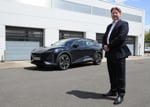By Professor Colin Herron, expert partner of Teletrac Navman
The global policies around low emission vehicles still have lots of moving parts. The key considerations are what vehicles, by class, can be sold as new vehicles after certain dates, and around this there is currently a lot of uncertainty.
When you look across key global markets, this is only compounded further when federal and state government legislation takes different approaches.
The majority of leading countries have set targets for the abolition of internal combustion engines (ICE) in new cars/vans sold from 2035, but their approaches differ tremendously.
In July 2021, the European Commission proposed to reduce the limit for emissions from cars and vans by a further 15% from 2025; followed by a 55% reduction for cars and 50% for vans by 2030 and to reach zero emissions by 2035.
The EU also announced that smaller manufacturers are set to be given an exemption from the 2035 ban with further exemptions for internal combustion engine cars powered exclusively by efuels (synthetic fuels manufactured using captured carbon dioxide or carbon monoxide, together with hydrogen obtained from water split by sustainable electricity sources such as wind, solar and nuclear power).
The UK is the first country in the world to commit to phasing out non-zero emission heavy goods vehicles weighing 26 tonnes and under by 2035, with all new HGVs sold in the UK to be zero emission by 2040.
The question of what energy source will dominate is still debated however, groups like Traton (a subsidiary of VW Group and one of the world’s largest commercial vehicle manufacturers) are saying all vehicles will be BEV (battery electric vehicle) while Volvo are offering hydrogen fuel cell vehicles.
For urban based HGV I believe they will be exclusively BEV.
Then looking to the US, because of its size and political complexities there are effectively 50 different mini countries all doing what they think is correct, from the pioneer California to other states who are not advancing as quickly.
There is no national strategy like there is in the UK or Australia or New Zealand.
What the strategy more-often-than-not falls back on is numbers of chargers and not by type.
But the three most influential factors for EV take up are:
1. The importance of the market to the vehicle manufacturer – is it lucrative enough to invest in EV development and rollout?
2. The politics of the state/authority/country – this will impact both the manufacturer and end customer.
3. The level of understanding of how to roll out infrastructure and can it operate with the local politics.
The risk of EV technology being unable to scale is very low – it’s quite simple and most of the technology has been around for many years.
The real risk is that the targets have been set but will industry have everything in place to achieve those targets. It is also important to be mindful; it is the political definitions of those targets, that are driving the behaviours of the vehicle manufacturers, which in turn directly impacts our ability to transition.
If you look back at the covid era, one of the biggest fears was that heavy goods vehicles would stop running, and if we were to ever have that situation, countries would collapse as supplies would stop.
It has become very clear that if we are setting a mandate for zero emission vehicles at a set point, the trucking industry needs to be prioritised.
If we do not have the infrastructure and the vehicles, are we to go back to diesel, if not diesel hydrogen or synthetic fuels? Will politicians fund multiple parallel infrastructures?
There are many questions unanswered for some vehicles, but in my opinion, most will go all electric, but some will use synthetic fuels. Time will tell.
As someone who has been involved in the EV infrastructure arena since its concept there are four points I regularly come back to:
1. We can put as many charge posts in the ground as we want but it will not increase EV registrations with private buyers. The controlling factors are cost and availability of vehicles. It will be 2025/26 before serious volume arrives at comparable prices, specifically, low specification (cost) models.
2. There is a serious lack of attention to the question of; how many charge posts are required by type, location and when. This is complex and requires correctly modelled policy at national and local government level.
3. Percentage market share means nothing, cars/vans/trucks and buses on the ground are what matters.
4. The grant systems that different governments use across the world are resulting in, and have resulted in, EV charge posts going in spaces where they shouldn’t necessarily be, having a level of impact on the pace of take-up and transition.
It is clear for some fleet operators, there are some journeys that will be a challenge with the current model availability both in terms of technology and numbers.
What we need to have is a concrete plan in place that enables policy, vehicle production and infrastructure modelling to interact more coherently.
The current trials in the UK with high power charging of HGV will be a very good guide to the future.






















Login to comment
Comments
No comments have been made yet.